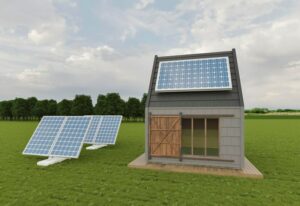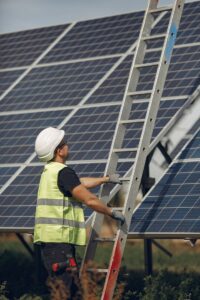
Green roofs emerge as innovative means to blend urban architecture with environmental consciousness in an era defined by the need for sustainable solutions. At the most fundamental level, a green roof refers to a building rooftop partially or wholly adorned with vegetation, growing atop a waterproof membrane. This concept extends beyond merely hosting a garden atop a building, encapsulating broader eco-innovations such as solar panel deployment and cool roofing technology. With a comprehensive understanding of green roofing, it becomes clear this concept is not just a design trend but a powerful tool for urban resilience and environmental sustainability.
Types of Green Roofs: Intensive and Extensive
Green roofs predominantly fall into two categories: intensive and extensive. An intensive green roof embraces a more traditional approach, featuring a thicker, heavier growing medium capable of supporting a diverse range of vegetation, including small trees and shrubs. Conversely, extensive green roofs lean towards minimalism, featuring a lighter, thinner layer of growing medium – often a specialized compost formulation. These roofs require less maintenance, typically only annual weeding and fertilization, making them an attractive option for buildings with limited regular roof access.
Harnessing Environmental Benefits
Green roofs offer a multitude of environmental benefits, acting as a living, breathing component of the urban ecosystem:
- Biodiversity Promotion: Green roofs provide habitats for plants, birds, and insects, restoring a touch of nature in the concrete-dominated urban landscape. Their ability to attract beneficial insects and birds, even on buildings as tall as 19 stories, highlights their role as urban biodiversity hotspots.
- Air and Water Purification: Green roofs help filter out heavy metals and pollutants from rainwater and contribute to air purification by generating oxygen, potentially reducing urban asthma rates.
- Urban Heat Island Mitigation: Green roofs can help reduce urban air temperatures by acting as natural coolants. Projections indicate that fully implementing green roofs in a city could lead to a remarkable average temperature drop of approximately seven degrees Celsius.
- Stormwater Management: Green roofs reduce stormwater runoff, easing the strain on urban sewage systems. Furthermore, vegetation and growing mediums act as natural filters for stormwater, lessening environmental pollution.
- Noise Insulation: Green roofs can serve as sound insulators, with plants blocking high frequencies and the soil absorbing low frequencies.
Financial and Community Advantages
Beyond their environmental impact, green roofs offer considerable financial and communal benefits:
- Prolonged Roof Lifespan: According to the Penn State University Green Roof Research Center, a properly installed green roof can extend the roof’s lifespan by 2-3 times.
- Energy Efficiency: An Environment Canada study revealed that green roofs could lead to a 26% reduction in cooling and heating needs, making them an effective energy-saving solution.
- Increased Property Value: Incorporating a green roof can increase the overall real estate value of the property, making it a sound long-term investment.
- Community Building: Green roofs can foster community connections, serve as aesthetic points of interest, and contribute to urban beautification. The psychological benefits of green spaces in urban settings, including reduced stress and improved mood, further underscore the importance of green roofs.

Considerations and Costs
Despite their many benefits, green roofs require an initial investment, ranging from $7-$15 per square foot for an extensive roof to $15-$25 per square foot for an intensive roof. This cost reflects the need for professional installation and the multiple layers in constructing a green roof. However, when considering the extended lifespan of the roof, reduced energy costs, and increased property value, the return on investment becomes apparent.
As cities worldwide grapple with the challenges# I am searching for the latest advancements in green roof technology to update the article with the latest information.
As cities worldwide grapple with urbanization and climate change challenges, green roofs are a promising solution combining aesthetics, economics, and environmental sustainability. With the ongoing advances in sustainable building technologies and materials, the potential for green roofs will only grow. Incorporating green roofs into urban planning and architecture leads to healthier, more resilient cities, underlining their importance in our collective journey toward a sustainable future.
Is a Green Roof Right for You?
The decision to install a green roof largely depends on personal preferences and circumstances. It is an excellent consideration when constructing a new building or replacing an existing roof. Green roofs emerge as a compelling option for individuals seeking to contribute to green living and sustainability by factoring in the environmental, financial, and personal benefits. While the initial investment may seem substantial, the long-term benefits and savings make it worthwhile.
As the world grapples with pressing environmental challenges, green roofs embody hope, merging urban life with nature and demonstrating that the path to sustainability may be above our heads.